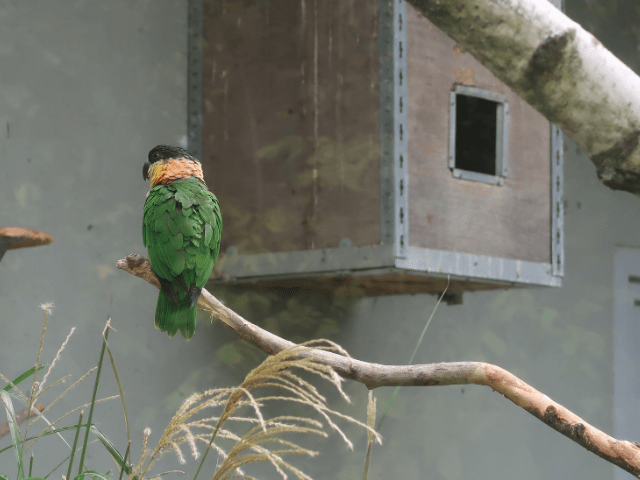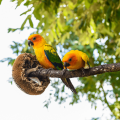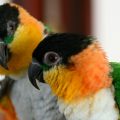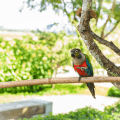Table of Contents
How to care for Caique parrots? In captivity the caique parrot is not as vocal as it would be if it were in the wild. Both of the caique species possess a variety of bird calls, squacks, screeches and shrieks. The black-headed caique parrot, though, makes a tooting sound that is specially its own. How to care for Caique parrots? It is believed that the black-headed caique does this in order to call out to other caiques. They, just like their cousins, the conures and pionus parrots, possess pretty soft voices, but packs a loud screech. Hence our suggestion of visiting the caique you have your eyes set on before the actual acquisition. How to care for Caique parrots? These small birds are better able at mimicking environmental sounds than they would human speech and words.
Feeding Your Pet
How to care for Caique parrots? Knowing what to feed your caique birds is an important bit to understand if you want your parrots to thrive well; both physically and mentally. All parrot species, big or small, have certain preferences for the food they seek out in the wild. Whilst some parrots like the Macau, prefer to dine on seeds; other parrots like the pionus, love the taste of nectar.
The caique parrot is no different when prefering some food sorts over others. The caique birds, for some reason, gravitate toward colourful flowers in the wild. They also seem to go for sweet tasting fruits they find in nature. A new caique pet owner should take the time to spend with their birds; in order to determine the caique bird’s preference for food. Of course, you must be initially aware of the foods they do zero in on to determine this.
Feeding Fruits
How to care for Caique parrots? In captivity, caique owners have observed that their caique birds prefer fruits such as grapes, pomegranates, apples, papaya, dried figs, cranberries; blueberries, apples, oranges, dried figs, etc. They also seem to favour corn, carrots, broccoli, green beans, snap peas, etc.
Cutting up their food in small portions big enough for their feet to pick up is the easiest way to entice a bird to eat their food. Not that they would need any coaxing from you; if the food you provide them are the ones they prefer and are nourished by correctly.
Pellet Food
How to care for Caique parrots? They may also be fed bird pellet food that can be found in the pet trade market. There are formulated diets that can be bought in pet shops and supermarkets that contain the proper amount of supplemental nutrition that is good for the caique birds you own. Be sure that you give them the proper ratio and portions of varied foods. You want to give them a feeding ratio of 45% formulated pellets: 35% fruits and veggies: 20% bird seed. Avoid giving caique birds too much bird seed because too much of bird seed can cause them to develop increased lipid levels in their blood supply; which can cause their feathers to change colours out of their usual hues.
Fresh Foods
How to care for Caique parrots? Serve up a bowl of the fresh foods you have diligently cut up for them; in the day time, allowing the birds to gobble up bits of food throughout the day. Experience has proven that scattering about a tablespoon full of sunflower seeds on the floor of their cage gives them a nice light snack after you have removed their fresh food bowl in the evening. If you are looking to breed your caiques then an important addition to their food fare would be protein; especially during the late autumn, early winter mating season.
Feeding for Breeding
How to care for Caique parrots? Breeding avians also require essential minerals, particularly calcium, which helps strengthen the eggshells of the clutch. You will notice that before the caique hen lays its eggs; she will noticeably become obsessed on chewing on anything that has minerals in it. You can supply your laden caique hen with a fresh cuttlebone. You may also want to add an oyster shell that would do the job as well. In addition, you can also provide them with a meant-for-human calcium tablet.
Without overdoing it; share a small piece of meat from your plate that has not been doused in artificial whatnots and that should hit the spot. They also like the occasional soft bodied larvae, and need essential amino acids that can only come from animal sourced meats. Manufacturers of formulated pellets include these in the pellets they make, but you can switch it up and serve up a half-inch slice of yellow cheese.
Parrot Treats
How to care for Caique parrots? Give them treats like the occasional pecan or walnut and of course, sunflower seeds can also be used as treats. Another treat they seem to like, whether in the wild or in captivity, is nectar. The caique bird, in nature, would gravitate toward the bacuri tree; which produced a cup-like blossom which contains the sweet nectar they oh-so love. The caique bird is an integral part of the natural life of nature since it acts as a pollinator of flora. Always remember to freshen up thei bird and drinking bowls with clean water. Providing them with clean water at all times ensures that water they drink or bathe in is not contaminated or murky.
Avian Cage
How to care for Caique parrots? Avian vets do not come cheap nor are there too many of them, so seek out one long before you start the process of acquiring your birds and their equipment. Make sure that your avian vet is not transiting or moving anytime soon, and that they can be reached and consulted for any eventualities in the future.
The reason we mention this, is because, avian vets have determined that most diseases suffered by a bird is due to unkempt and unsanitary cage conditions. Make sure that you give the cage of the birds, daily maintenance by clearing out soiled floor lining (you may use newspapers for this task). Make it a point that bird baths and drinking bowls are replaced with fresh clean water regularly. Some people like to do it once in the morning, and again at night. However, should the water immediately become murky with food debris or bird poop, make sure that it is replaced immediately.
Cleaning and Maintenance
How to care for Caique parrots? Maintenance of enclosure mean taking stock of not only the cleanliness of the cage, it also includes all the fittings and furnishings you have placed inside of the cage. It will be important for you to realize that investing on the best sundries that will last you and your birds.
You want to avoid using any furnishings that have toxic ingredients in them. Ceramic or stainless steel bowls are the best and most durable of drinking, feeding and bird bath bowls. You will also need to remove and replace swings, perches and twigs that are inside of the cage when they have deteriorated or when they are too banged up for proper utilization.
Cage Dimensions
How to care for Caique parrots? For an individual or a couple living in a small spaced apartment and is looking to get a caique parrot, you will be glad to know that a 24x24x18 will be sufficient and ample space to provide your caique bird. Make sure though that you remember to keep windows and doors closed when you have trained your bird well enough and it is allowed to fly and roam freely around a controlled space.
Get to know the Caique parrot in this chapter and find out all about the little guys with their colourful feathers and how to best showcase and enjoy them. A truly great companion and well able to survive and thrive solo, the caique is a parrot that is fairly independent and can amuse itself during times of the day when you are out of the house. Be sure though, that you not only provide it with toys to keep it occupied but remember to set aside ample play time with your caique.
Nesting and Breeding
How to care for Caique parrots? They are bird species who has a long lifespan that can exceed 2 decades and more in captivity. The caique parrot is considered a mature bird between 2 to 3 years. In the wild it finds nesting places in the hollow of tree trunks. They come together and mate toward the tail end of the year, sometime in October, but breeding also largely depends on where the caique is from. Only a DNA test or an endoscopy will be able to determine the sex of the caique parrot. They are constantly chewing on things, so make sure that you provide them with a lot of toys and plenty of replaceable perches.
Conclusion
How to care for Caique parrots? In order for birds, like the caique parrot, to live to its fullest potential and enjoy a life in the safety of captivity, you as its new caregiver will need to provide it with. Make sure that you have enough space in your home to house a caique bird comfortably. Caique birds are pretty quiet birds save for the occasional tweeting and chirping since they are not big talkers, so they will be perfect pets for those living in close proximity to their neighbors.






 Author and long-time animal lover. Sharing knowledge on pet care through experience and the written word.
Author and long-time animal lover. Sharing knowledge on pet care through experience and the written word.